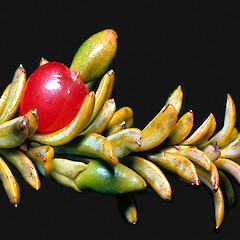Podocarpus nivalis
Common name
mountain tōtara, snow tōtara
Synonyms
Podocarpus nivalis Hook. var. nivalis, Podocarpus nivalis var. erectus Cockayne
Family
Podocarpaceae
Flora category
Vascular – Native
Endemic taxon
Yes
Endemic genus
No
Endemic family
No
Structural class
Trees & Shrubs - Gymnosperms
NVS code
The National Vegetation Survey (NVS) Databank is a physical archive and electronic databank containing records of over 94,000 vegetation survey plots - including data from over 19,000 permanent plots. NVS maintains a standard set of species code abbreviations that correspond to standard scientific plant names from the Ngä Tipu o Aotearoa - New Zealand Plants database.
PODNIV
Chromosome number
2n = 38
Current conservation status
The conservation status of all known New Zealand vascular plant taxa at the rank of species and below were reassessed in 2017 using the New Zealand Threat Classification System (NZTCS) – more information about this can be found on the NZTCS website. This report includes a statistical summary and brief notes on changes since 2012 and replaces all previous NZTCS lists for vascular plants.
Please note, threat classifications are often suggested by authors when publications fall between NZTCS assessment periods – an interim threat classification status has not been assessed by the NZTCS panel.
- Conservation status of New Zealand indigenous vascular plants, 2017 . 2018. Peter J. de Lange, Jeremy R. Rolfe, John W. Barkla, Shannel P. Courtney, Paul D. Champion, Leon R. Perrie, Sarah M. Beadel, Kerry A. Ford, Ilse Breitwieser, Ines Schönberger, Rowan Hindmarsh-Walls, Peter B. Heenan and Kate Ladley. Department of Conservation. Source: NZTCS and licensed by DOC for reuse under the Creative Commons Attribution 4.0 International licence.
2017 | Not Threatened
Previous conservation statuses
2012 | Not Threatened
2009 | Not Threatened
2004 | Not Threatened
Distribution
Endemic. New Zealand: North Island and South Island from Mt Hikurangi and Mt Pirongia south.
Habitat
Montane to alpine (virtually confined to subalpine and alpine areas in the North Island). Common in open tussock grassland, subalpine scrub and herbfield, at the base of active scree, amongst boulderfalls and on cliff faces and razorback ridges. Sometimes extending down into beech (Nothofagaceae forest) and down into valley heads.
Detailed description
Prostrate to suberect, spreading woody shrub forming broadly domed patches up to 1.5 × 3.0 m. Trunk usually indistinct (mostly obscured by branches), slender, solitary (sometimes several arising from base). Branches numerous, spreading with slender trunk, branchlets densely leafy. Leaves bronze-green, dark green, sometimes dark wine-red or bronze-purple, closely spaced, spirally arranged, erect or sub-patent, rigid, coriaceous; lamina 5–15 × 2–4 mm, linear-oblong,± subulate, obtuse, apex ± apiculate, margins distinctly thickened, midvein prominent. Male strobili axillary, solitary or up to 4 per peduncle; peduncle 3–5 mm long, strobilus 5–15 mm long, apiculus obtuse. Female branchlet axillary, peduncle 3 mm. long, receptacle 2.5–10.0 mm long, red, elliptic-oblong to obovate-oblong, slightly compressed, smooth, swollen (fleshy). Seeds solitary or paired, 3·5–7·0 mm long, green when fresh, ovoid or ellipsoid-ovoid, weakly asymmetric, obtusely pointed.
Similar taxa
None. The prostrate or spreading suberect, heavily branched growth habit, densely leafy branchlets, and small, closely spaced, awl-shaped usually bronze-green leaves serve to distinguish this species from the other allied species of tōtara. Nevertheless where the ranges of Podocarpus nivalis overlap with that of Hall’s tōtara (P. laetus), tōtara (P. totara var. totara) and needle-leaved tōtara (P. acutifolius) hybrids can be common—these are chiefly distinguished by their suberect to erect growth habit, often pendulous branches and much longer, narrower leaves which are not distinctly awl-shaped. The hybrids are fully fertile and introgressive hybrid swarms are sometimes common, especially where the ranges of Hall’s tōtara and P. nivalis overlap. Podocarpus nivalis has also been confused with the Australian P. lawrencei which differs from P. nivalis in a range of characters but most notably by its consistently dark purple-brown coloured foliage.
Flowering
September–November
Flower colours
No flowers
Fruiting
December–June
Propagation technique
Easily grown from hardwood cuttings and fresh seed. Does well in full sun in a well drained, moist fertile soil. An excellent shrub for a rockery or small garden. A good subject for a tub garden or for making into bonsai. Despite its natural distribution Podocarpus nivalis is remarkably tolerant of drought and humidity.
Etymology
podocarpus: Foot or stalk fruit
nivalis: Snow dweller
Taxonomic Notes
Podocarpus nivalis has also (incorrectly) been referred by some New Zealand authors to the Australian endemic P. lawrencei.
Attribution
Factsheet prepared for NZPCN by P.J. de Lange 4 January 2012. Description adapted from Allan (1961) and Webb & Simpson (2001).
References and further reading
Allan HH. 1961. Flora of New Zealand, Volume I. Indigenous Tracheophyta: Psilopsida, Lycopsida, Filicopsida, Gymnospermae, Dicotyledones. Government Printer, Wellington, NZ. 1085 p.
de Lange PJ. 1998. Two interesting plant records from Mt. Pirongia western Waikato. Auckland Botanical Society Journal 53: 66–69.
Webb CJ, Simpson MJA. 2001. Seeds of New Zealand Gymnosperms and Dicotyledons. Manuka Press, Christchurch. 428 p.
NZPCN Fact Sheet citation
Please cite as: de Lange, P.J. (Year at time of access): Podocarpus nivalis Fact Sheet (content continuously updated). New Zealand Plant Conservation Network. https://www.nzpcn.org.nz/flora/species/podocarpus-nivalis/ (Date website was queried)











